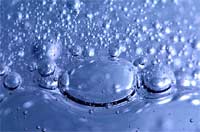Metal particle generates new hope for H2 energy
28 Jun 2011
Tiny metallic particles produced by University of Adelaide chemistry researchers are bringing new hope for the production of cheap, efficient and clean hydrogen energy.
 Led by Associate Professor Greg Metha, head of chemistry, the researchers are exploring how the metal nanoparticles act as highly efficient catalysts in using solar radiation to split water into hydrogen and oxygen.
Led by Associate Professor Greg Metha, head of chemistry, the researchers are exploring how the metal nanoparticles act as highly efficient catalysts in using solar radiation to split water into hydrogen and oxygen.
"Efficient and direct production of hydrogen from solar radiation provides a renewable energy source that is the pinnacle of clean energy," said Associate Professor Greg Metha. "We believe this work will contribute significantly to the global effort to convert solar energy into portable chemical energy."
The latest research is the outcome of 14 years of fundamental research by Associate Professor Metha's research group investigating the synthesis and properties of metal nanoparticles and how they work as catalysts at the molecular level.
The group works with metal "clusters" of about one-quarter of a nanometre in size - less than 10 atoms. Associate Professor Metha said these tiny "magic clusters" act as super-efficient catalysts. Catalysts drive chemical reactions, reducing the amount of energy required.
"We've discovered ways of producing these tiny metallic clusters, we've explored their fundamental chemical activity, and now we are applying their catalytic properties to reactions which have great potential benefit for industrial use and the environment," said Associate Professor Metha.


.webp)




























